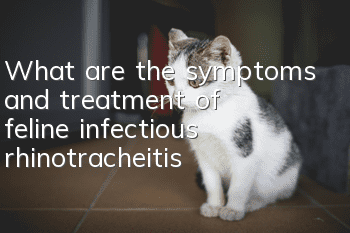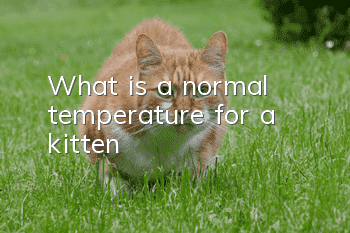What are the symptoms and treatment of feline infectious rhinotracheitis?

Infectious rhinotracheitis is an infectious disease caused by feline herpesvirus type 1. Clinically, it is characterized by sneezing, tearing, conjunctivitis, and rhinitis. Although the disease will not directly kill the cat, it will greatly reduce the cat's sensitivity to the taste of food, resulting in a refusal to eat, and eventually death. So let’s take a look at an introduction to feline infectious rhinotracheitis.
Pathogens and Epidemiology
The causative agent of this disease is feline herpesvirus type Ⅰ, which belongs to the family Herpesviridae and subfamily Aherpesvirinae. It is a double-stranded RNA virus with an envelope. This virus mainly infects kittens. The virus is excreted through nasal, pharyngeal, and eye secretions and infected through droplets. The incidence rate is 100% and the mortality rate is 50%. Adult cats generally rarely die, and the incubation period is generally 2 to 6 days.
Symptoms and pathological changes
At the beginning of the disease, the sick cat has an elevated body temperature, listlessness, sneezing, coughing, tearing and runny nose. The nasal discharge is initially transparent serous, and then gradually turns into mucus and purulent secretions. Kittens lose appetite and lose weight. Some sick cats become chronic and manifest as cough, dyspnea and sinusitis. Pregnant female cats can cause miscarriage and stillbirth. Hematological examination showed a decrease in the total number of white blood cells and neutropenia. Pathological autopsy showed diffuse hemorrhage and necrosis in the nasal cavity, turbinate mucosa, larynx, trachea and bronchial mucosa. In more severe cases, mucosal necrosis occurs in the nasal cavity and turbinate bones, and small necrotic lesions also appear in the mucosal epithelium of the conjunctiva, tonsils, epiglottis, tracheobronchi, and bronchioles. Histological examination can isolate inclusion bodies from the epithelial tissue of the nasal cavity, tonsils, and trachea.
How is feline infectious rhinotracheitis transmitted?
For feline infectious rhinotracheitis, an infectious disease, prevention is more important than treatment, so we should have a certain understanding of the way the disease is transmitted, so as to help us better prevent this disease and reduce The chance of a cat dying from a disease. So let’s take a look at how feline infectious rhinotracheitis is transmitted.
1. The virus is transmitted through direct contact with cats. This is the main mode of transmission of feline viral rhinotracheitis. The virus is excreted through secretions from the nose, eyes, and mouth. Sick cats and healthy cats are infected through the respiratory tract through direct nose-to-nose contact and inhalation of virus-containing droplets. This type of transmission is most common in cat shelters, breeding farms, or places where there are several cats in the home, so if one cat in these places gets the disease, the other cats are likely to be affected as well. .
2. Indirect transmission. Feline infectious rhinotracheitis virus can contaminate the surrounding environment such as furniture, water dishes, food dishes, cat litter dishes, cages and walls when cats sneeze or cough or saliva.Other healthy cats will be infected by the virus and become ill when they come into contact with these virus-contaminated things. The virus can also be transmitted to other cats through people and their clothing. Therefore, it is important to take the cat to the animal hospital for medical treatment or beauty treatment. When visiting the store, you must be careful that cats are indirectly infected in these places. In addition, owners must change their clothes immediately after returning home from these places or pet markets and take disinfection measures before coming into contact with cats at home.
3. Maternal transmission. Feline viral rhinotracheitis virus can be transmitted from female cats to kittens through the placenta, so cats with this disease cannot become pregnant.
Prevention and treatment of feline infectious rhinotracheitis
Since feline infectious rhinotracheitis is a contagious disease, owners who raise multiple cats at the same time must pay attention. If a cat is found to have symptoms similar to the disease, it is best to treat it Isolate individually, and then ventilate and disinfect the room. Then we will discuss the prevention and treatment of feline infectious rhinotracheitis.
Prevention
The prevention of this disease mainly relies on immunization. Currently, the commonly used vaccines include attenuated rhinotracheitis vaccine and cells. Culture inactivated vaccine. Feline distemper, feline infectious rhinoconjunctivitis, and feline rhinotracheitis triple attenuated vaccines can also be used for immunization.
Treatment
This disease mainly adopts symptomatic treatment and anti-secondary infection treatment.
1. If the symptoms of keratitis are obvious, use ofloxacin eye drops, 10% sulfonacetamide, and chloramphenicol eye drops. If the symptoms of rhinitis are obvious, wipe the area around the nasal cavity frequently with a towel and apply furosemide nasal drops into the nose.
2. If the cough is obvious, take compound licorice tablets orally and perform oxygen inhalation and aerosol treatment. To prevent secondary infection, cefazolin sodium, or ampicillin, Shuanghuanglian, and Shegan antiviral intramuscular injections can be used.
3. Sick cats should be treated in isolation, and the isolation treatment room should be kept at a constant temperature. Cats with oral damage and long disease course should be injected intramuscularly with vitamin A.
- Can kitten diarrhea heal on its own?
- How to correct a cat that scratches the ground next to its food bowl
- How to identify a false pregnancy in a female cat
- What to do if Birman cat has urinary stones. How to treat Birman cat to have urinary stones.
- What are the benefits of giving probiotics to cats?
- Why does my cat’s butt bleed?
- How to remove black lumps on cat's nose?
- Why do American Bobtail cats need to be neutered?
- Are Ragdoll cats suitable for novice owners? Things to note for newbies raising Ragdoll cats!
- Which pet attracts fleas the most? Take you through the life of a flea!



